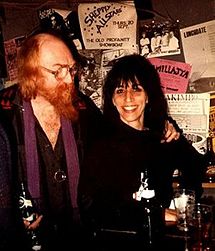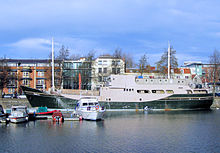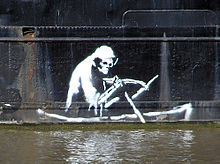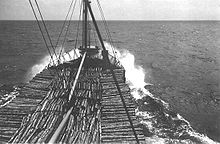The Thekla
|
|
This article needs additional citations for verification. (February 2012) |
| The Old Profanity | |
|---|---|
 Vivian and Ki in the hold, early days |
|
| Address | Floating Harbour |
| City | Bristol |
| Country | England |
| Designation | Showboat |
| Capacity | Variable |
| Opened | 1984 |
| Previous names | Thekla |
| Production | Visiting performances |
| Current use | Music venue |
| Website | |
| www.thelkabristol.co.uk | |
Coordinates: 51°26′57″N 2°35′43″W / 51.44917°N 2.59518°W
Thekla is a cargo ship moored in the Mud Dock area of Bristol's Floating Harbour, England. Originally brought to Bristol as the Old Profanity Showboat, it was a late 1982 brainchild of novelist Ki Longfellow-Stanshall, the wife of Vivian Stanshall. The showboat was based on the idea of creating, owning, and running a theatre on a seagoing ship and using it to showcase music of every sort (limited only by the size of the hold), including cabaret, comedy, plays, musicals, and poetry events. The ship also contained an art gallery. The living quarters were home for Vivian, Ki, their daughter, Silky Longfellow-Stanshall, and Ki's daughter, Sydney Longfellow, as well as a few key personnel. During the 1990s, under new management, it was run as a rent-a-nightclub. The ship has now been returned to its original working name of The Thekla.
Contents |
Construction and Working life[edit]
The Thekla was built in Germany in 1959. One of the last of the riveted ships to be produced[clarification needed], she was 650 tons unladen, measured one hundred and eighty feet long from stem to stern, and thirty feet wide, with an eight foot draft. The Thekla's hold was lined with one of the hardest woods in the world, red jarrah from Australia. She is a "Coaster" ship and powered by a U-boat engine left over from the Second World War). The Thekla was used for more than twenty years to transport timber to and from ports of the Baltic Sea. After running aground at Gravesend in Kent she was left rusting away for seven years in the half-abandoned docks of Sunderland on the eastern coast of England, before being purchased by the Stanshalls.
Finding and converting a ship into a showboat[edit]
The Stanshalls obtained funds from The Small Firms Loan Guarantee Scheme, whereby a bank lends the money, and the UK government guarantees the loan. The SS Thekla was considered ideal. Everything had to be refurbished from the U-boat engine (left over from the Second World War, as mentioned above), to the leaky hydraulics to the winch for raising and lowering the anchors. In the summer of 1983, she set sail for Bristol on the opposite side of Britain, a city chosen because Vivian had once played there as frontman for The Bonzo Dog Band, and because Ki liked the sound of the place.
Fresh out of dry dock with her bottom scraped, she was covered in a new coat of black paint and white paint over her original colors of pale blue and white, with red chosen for the stack. With all the ironwork and welding accomplished, the SS Thekla sailed 732 nautical miles (1,356 km) to Bristol in six days and six nights.
Sailing into tumult[edit]
From the open sea, the Thekla entered the Severn on August 4, 1983 and navigated its waters until it arrived in the Floating Harbour of the city of Bristol, and where it is still moored.
She had sailed without ballast, without registration, without insurance, and without mishap, save for the half day the crew spent mending the engine. Her conversion, sailing, docking, finishing touches, and opening night on 1 May 1984 was filmed as an Omnibus BBC 1 documentary by writer and film maker Tony Staveacre of the BBC. He called it The Bristol Showboat Saga and it was broadcast for the first time on 30 September of that year.
Old Profanity days[edit]
For the next two and a half years, The Old Profanity Showboat put on over 240 theatrical productions, staging the varied efforts of theatrical troupes from all over Britain, plus the work of the students of the nearby Bristol Old Vic Theatre School. It was one of the first venues to stage Robert Longden and Hereward Kaye's Moby Dick the Musical to packed houses.
To support its theatre and cabaret (which seldom paid for itself), the Old Pro also provided a stage for bands.
Within a year, the Old Pro was in use as a small theatre, jazz venue, folk club and cabaret. Across her stage came hopefuls who became "names," and often unannounced "names" who wanted to once again experience the intimacy of their first foray into show business. Many of Britain's best and brightest comedians either played there, or stayed[1] there.
Stinkfoot[edit]
Many of the Old Pro's employees[2] worked the bar or the box office or ship's maintenance in order to find themselves one day treading her stage. After two years of waiting, Ki felt they could wait no longer. No matter how much it cost to stage an original show, the time had come to reward their hard work and dedication.
Co-written by Vivian Stanshall and Ki Longfellow-Stanshall, Stinkfoot, a Comic Opera[3] was a three-hour long musical comedy (Vivian called it a "comic opera[4]"), produced by Ki, directed by Vivian (working with both actors and orchestra at the same time), and performed on the Old Pro over a two-week run up to Christmas in December 1985. Stinkfoot's cast and orchestra[5] consisted of the employees, as well as regulars who'd graced Thekla's stage. Its set made use of Thekla's curious layout. Its conception was based on a series of tales Ki wrote about a New York City alley cat and on Vivian's life as a Bonzo frontman. In its final form, it was a surreal and dazzling cross-cultural mix of music hall, Broadway, and Thirties screwball comedies. But mostly, it was "just being itself," as Vivian would say. It played to sell-out audiences every single night of its run, attracted people from Scotland to the USA, and it garnered wonderful, if slightly puzzled, reviews from not only the Bristol press, but The Guardian and The Times.
Staged a second time in late 1988 at the Bloomsbury Theatre in London, it lacked the cockeyed appeal of Thekla's unusual setting, and the hand-picked Bristol cast and orchestra (for which much of the material was specifically crafted).
In late 2008, interest in restaging the show became a reality. The comic opera, trimmed from three hours to two, is now in pre-production for a British revival. A "Stinkfoot Showcase" played the Thekla (where it was written and first staged), on July 20, 21, 22nd, and 24th of 2010. This was a showcase of Stinkfoot's songs backed by a full band and selected cast members (including Nikki Lamborn and Vivian and Ki's daughter Silky Longfellow-Stanshall) plus special guests. Tony Slattery narrated and sang. Though open to the public, the showcase was intended to attract backers for the revival of the full musical. It attracted the attention of major press (The Word magazine, Mojo magazine, BBC London & BBC Bristol), and theatres like the Bristol Old Vic.
Closure[edit]
By early 1986, even though the ship had survived the expense of staging Stinkfoot, and even though there was a plan to sail the Thekla at least to the port of New York City to try her artistic mettle there, Ki had become exhausted by the day to day running of such a huge venture. Vivian, buoyed by the experience of Stinkfoot, was eager to renew his recording career, and Ki to continue her career as a novelist. Ki was also experiencing ill-health due to the stress of managing something so complex as The Old Profanity Showboat. Announcing closure of the ship, there came a deluge of protest by artists and customers whose home it had become. Accordingly, the Old Pro continued to showcase theater and bands until August 1986.
Ki, Vivian, and Silky retreated to the Bristol home of an Old Profanity regular, the actor David Rappaport (who appeared in the film Time Bandits).
1990s to present day[edit]


Throughout the 1990s and into the early 2000s, the Thekla was taken over and run as an underground nightclub, becoming a cornerstones of Bristol's drum & bass music scene. Over these years some of Bristol's best known artists (including Massive Attack, Portishead and Roni Size) began by playing in the Thekla's hull.
Work by the artist Banksy can be seen stencilled over the bulkheads inside the club as well as his much larger work on the outside of the hull at the waterline. This piece was painted over by the harbour master, much to the annoyance of the club's owners, who threatened the council and harbour master with legal action. Banksy returned to paint it again.
A refurbishment of the ship was completed in October 2006 after being purchased by Daybrook House Promotions, owners of Rock City, Rescue Rooms, Stealth and The Bodega in Nottingham. She remains at the moorings in central Bristol where she was first positioned in 1983 and continues to function as a music venue and nightclub. Artists such as Franz Ferdinand, The New York Dolls, Pete Doherty, Tokyo Police Club, Santigold and local bands from Bristol and Bath have played at the Thekla since DHP purchased the venue. The ship was repainted from black to cream and dark green.
In May 2009 the Thekla celebrated its 25th anniversary with a day and night long event featuring bands selected to represent the best of what was happening on the Bristol music scene.
See also[edit]
Footnotes[edit]
- ^ The Thekla is still moored in Bristol's Floating Harbour where she was docked in 1983. Today she is used as a venue for bands and club nights.
- ^ No advertisements were ever placed anywhere. No one was ever actually interviewed and formally "hired." Thekla's people either came from the Bristol Old Vic Theatre School, or as customers ... and kept returning until a place was found for them.
- ^ The Bristol production of Stinkfoot was celebrated in print with Stinkfoot:An English Comic Opera by Sea Urchin Editions, with full script, song lyrics, cast, artwork by Stanshall, and an introduction by Ki.
- ^ It was not, he insisted, about Christmas, or for Christmas, and it certainly was not a pantomime, a very British style of entertainment traditionally put on in theatres over the Christmas period.
- ^ Stanshall called it his "awkestra"
References[edit]
- Venue: 24 Apr - 3 May 2009 edition, Bristol's "What's On" magazine.
External links[edit]
| Wikimedia Commons has media related to: Thekla |
- Official Vivian Stanshall site and more about the boat
- Thekla site Current site with gig and club night listings
- The Thekla today
- Stinkfoot Stinkfoot page
- An affectionate look at Stinkfoot, the Old Pro, and the Stanshalls
- Stinkfoot's publisher Click 'About Us' then on one of the three publishers
- The Bonzo Dog Band site
- SHARE The Vivian Stanshall Appreciation Society and archive
- Memories of Moby Dick in Bristol (although the ship is not Swedish)
- Ki Longfellow's latest work
- Los Campesinos Rocking the Thekla



